2009 Hyundai Santa Fe engine
[x] Cancel search: enginePage 157 of 269

2DRIVING YOUR HYUNDAI
12
C090H01L-GAT NOTE:
o For smooth and safe operation,depress the brake pedal when shifting from "Neutral" position or "Park" position to a forward orreverse gear.
o The ignition key must be in the "ON" position and the brake pedalfully depressed in order to move the shift lever from the "P" (Park) position to any of the other posi-tions.
o It is always possible to shift from
"R", "N", or "D" position to "P" position. The vehicle must be fully stopped to avoid transaxledamage.
C090I03L-GAT
CAUTION:
o Shift into "R", "D" and "P" posi- tion only when the vehicle hascompletely stopped.
o Do not accelerate the engine in reverse or any of the forward po-sitions with the brakes applied.
! o Always apply the footbrake when
shifting from "P" or "N", to "R" or "D" position.
o Do not use the "P" (Park) position in place of the parking brake.Always set the parking brake, shift the transaxle into "P" (Park) posi- tion and turn off the ignition whenyou leave the vehicle, even mo- mentarily. Never leave the vehicle unattended while the engine isrunning.
o When accelerating from a stop on
a steep hill, the vehicle may havea tendency to roll backwards. Shifting the shift lever into 2nd gear while in Sport mode willhelp prevent the vehicle from roll- ing backwards.
o Check the automatic transaxle fluid level regularly, and add fluid as necessary.
o See the maintenance for the proper fluid recommendation.
C090J01NF-GAT Shift Lock Release If you cannot move the shift lever from the "P" (Park) position to any other position with the brake pedal fully de- pressed and the ignition key in the "ON"position, remove the cap on the con- sole and with a thin object such as a flat-head screwdriver, push the shiftlock release button down. Then, with the brake pedal depressed, move the shift lever to the desired position, andthen the shift lock release button will automatically return to its original posi- tion after shifting from the "P" (Park)position. Then, reinstall the cap. OCM053005R
CM-aust-2.p65
5/19/2008, 6:34 PM
12
Page 158 of 269
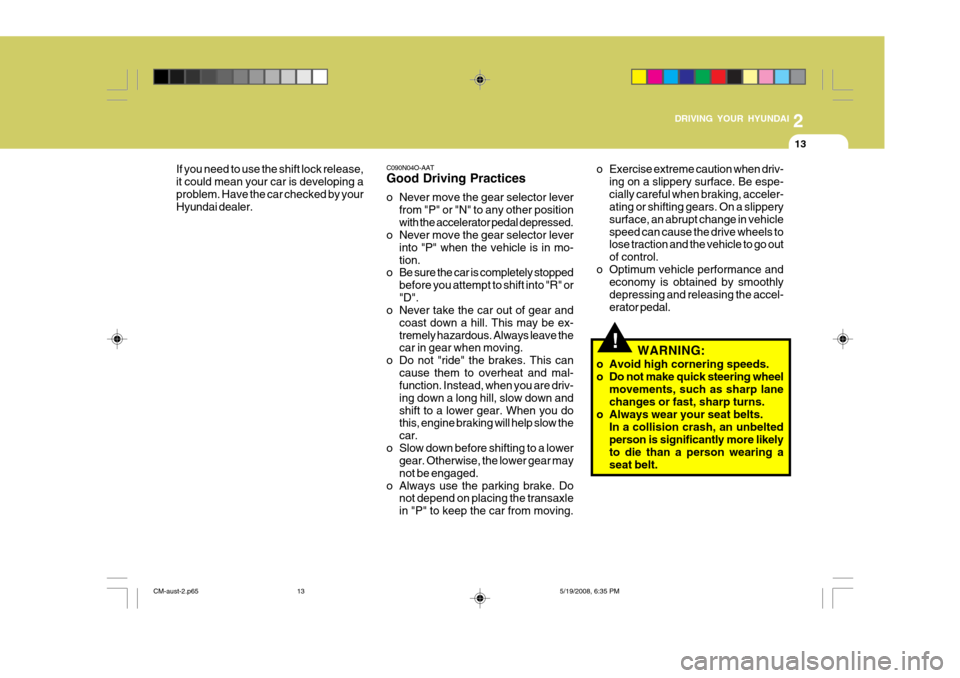
2
DRIVING YOUR HYUNDAI
13
!
C090N04O-AAT Good Driving Practices
o Never move the gear selector lever
from "P" or "N" to any other position with the accelerator pedal depressed.
o Never move the gear selector lever
into "P" when the vehicle is in mo-tion.
o Be sure the car is completely stopped
before you attempt to shift into "R" or"D".
o Never take the car out of gear and
coast down a hill. This may be ex-tremely hazardous. Always leave the car in gear when moving.
o Do not "ride" the brakes. This can cause them to overheat and mal-function. Instead, when you are driv- ing down a long hill, slow down andshift to a lower gear. When you do this, engine braking will help slow the car.
o Slow down before shifting to a lower gear. Otherwise, the lower gear maynot be engaged.
o Always use the parking brake. Do not depend on placing the transaxlein "P" to keep the car from moving.
If you need to use the shift lock release,it could mean your car is developing aproblem. Have the car checked by your Hyundai dealer.
o Exercise extreme caution when driv-
ing on a slippery surface. Be espe- cially careful when braking, acceler- ating or shifting gears. On a slippery surface, an abrupt change in vehiclespeed can cause the drive wheels to lose traction and the vehicle to go out of control.
o Optimum vehicle performance and economy is obtained by smoothlydepressing and releasing the accel-erator pedal.
WARNING:
o Avoid high cornering speeds.
o Do not make quick steering wheel movements, such as sharp lane changes or fast, sharp turns.
o Always wear your seat belts. In a collision crash, an unbelted person is significantly more likelyto die than a person wearing a seat belt.
CM-aust-2.p65 5/19/2008, 6:35 PM
13
Page 159 of 269
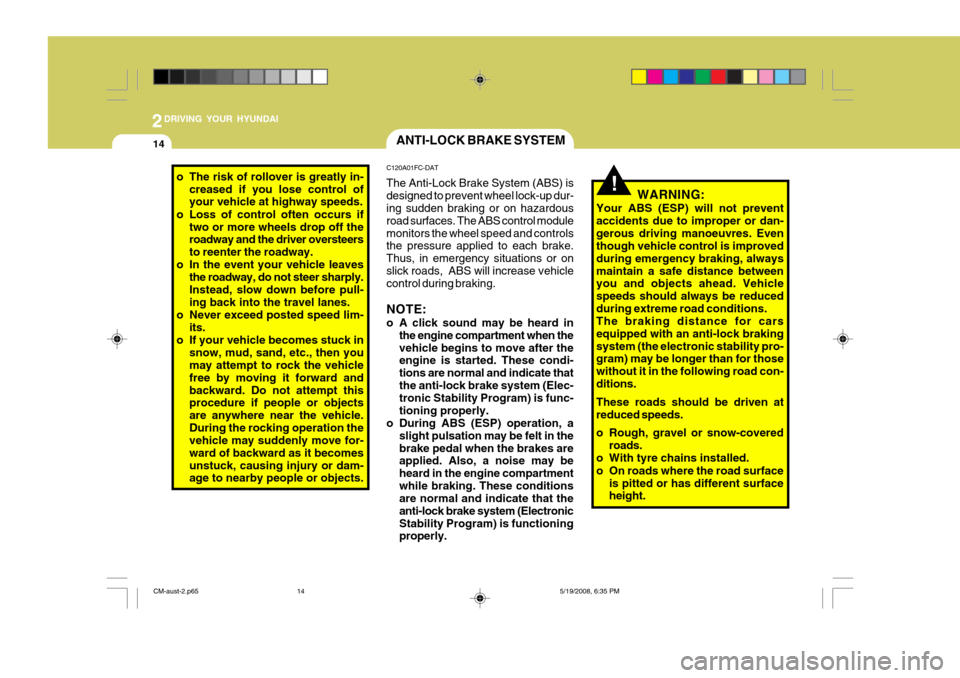
2DRIVING YOUR HYUNDAI
14
o The risk of rollover is greatly in-
creased if you lose control of your vehicle at highway speeds.
o Loss of control often occurs if two or more wheels drop off theroadway and the driver oversteers to reenter the roadway.
o In the event your vehicle leaves the roadway, do not steer sharply.Instead, slow down before pull- ing back into the travel lanes.
o Never exceed posted speed lim- its.
o If your vehicle becomes stuck in
snow, mud, sand, etc., then youmay attempt to rock the vehicle free by moving it forward andbackward. Do not attempt this procedure if people or objects are anywhere near the vehicle.During the rocking operation the vehicle may suddenly move for- ward of backward as it becomesunstuck, causing injury or dam- age to nearby people or objects.!WARNING:
Your ABS (ESP) will not prevent accidents due to improper or dan-gerous driving manoeuvres. Even though vehicle control is improved during emergency braking, alwaysmaintain a safe distance between you and objects ahead. Vehicle speeds should always be reducedduring extreme road conditions. The braking distance for cars equipped with an anti-lock brakingsystem (the electronic stability pro- gram) may be longer than for those without it in the following road con-ditions. These roads should be driven at reduced speeds.
o Rough, gravel or snow-covered roads.
o With tyre chains installed.
o On roads where the road surface is pitted or has different surface height.
ANTI-LOCK BRAKE SYSTEM
C120A01FC-DAT The Anti-Lock Brake System (ABS) is designed to prevent wheel lock-up dur- ing sudden braking or on hazardous road surfaces. The ABS control modulemonitors the wheel speed and controls the pressure applied to each brake. Thus, in emergency situations or onslick roads, ABS will increase vehicle control during braking. NOTE:
o A click sound may be heard in the engine compartment when the vehicle begins to move after the engine is started. These condi- tions are normal and indicate thatthe anti-lock brake system (Elec- tronic Stability Program) is func- tioning properly.
o During ABS (ESP) operation, a
slight pulsation may be felt in thebrake pedal when the brakes are applied. Also, a noise may be heard in the engine compartmentwhile braking. These conditions are normal and indicate that the anti-lock brake system (ElectronicStability Program) is functioning properly.
CM-aust-2.p65 5/19/2008, 6:35 PM
14
Page 160 of 269
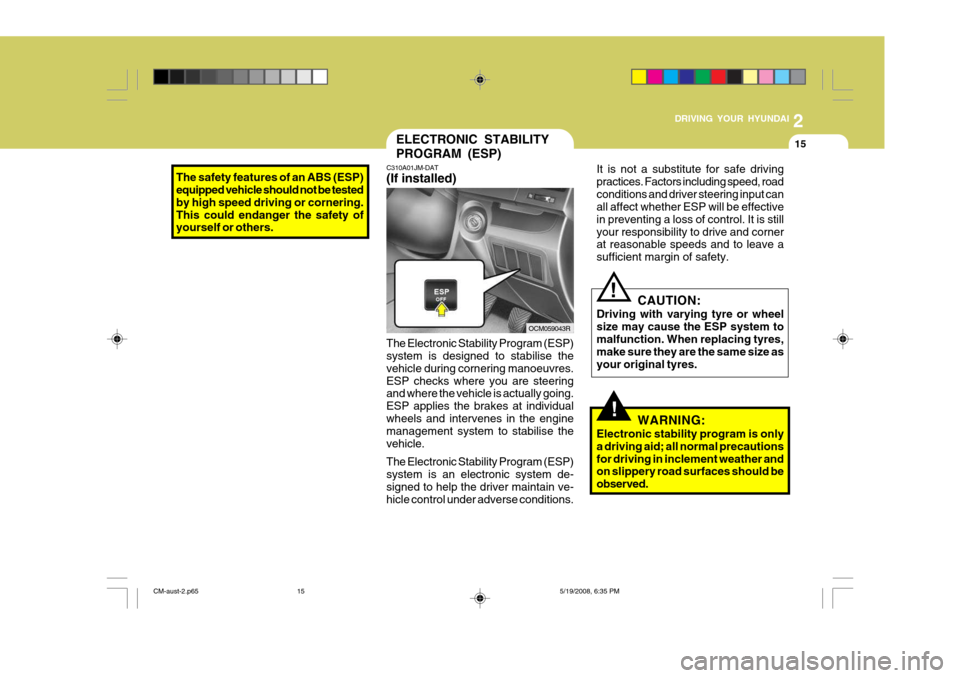
2
DRIVING YOUR HYUNDAI
15
The safety features of an ABS (ESP) equipped vehicle should not be tested by high speed driving or cornering.This could endanger the safety of yourself or others.
!
It is not a substitute for safe driving practices. Factors including speed, roadconditions and driver steering input can all affect whether ESP will be effective in preventing a loss of control. It is stillyour responsibility to drive and corner at reasonable speeds and to leave a sufficient margin of safety.
CAUTION:
Driving with varying tyre or wheelsize may cause the ESP system to malfunction. When replacing tyres, make sure they are the same size asyour original tyres.
WARNING:
Electronic stability program is onlya driving aid; all normal precautionsfor driving in inclement weather and on slippery road surfaces should be observed.
!
ELECTRONIC STABILITY PROGRAM (ESP)
C310A01JM-DAT (If installed) The Electronic Stability Program (ESP) system is designed to stabilise the vehicle during cornering manoeuvres.ESP checks where you are steering and where the vehicle is actually going. ESP applies the brakes at individualwheels and intervenes in the engine management system to stabilise the vehicle. The Electronic Stability Program (ESP) system is an electronic system de-signed to help the driver maintain ve- hicle control under adverse conditions. OCM059043R
CM-aust-2.p65
5/19/2008, 6:35 PM
15
Page 161 of 269

2DRIVING YOUR HYUNDAI
16FULL-TIME 4WD OPERATION
C350A03O-DAT Engine power can be delivered to all front and rear wheels for maximum power. Full-time 4WD is useful when good traction is required, such as, whendriving on slippery, wet or snow-cov- ered roads and when moving out of mud. Driving 4WD Safely
(1)Be sure to wear the seat belt.
(2)Drive at lower speeds in strong cross- winds. Because of your vehicle's high centre of gravity, its stability will be affected in crosswinds. Slowerspeeds ensure better vehicle con- trol.
(3)Check the brake condition after driv- ing in wet or muddy conditions. Pressthe brake several times as you move slowly until you feel normal brakingforces return.
(4)Do not drive the vehicle through wa-
ter. (i.e. streams, rivers, lakes, etc.)
C310B01JM-AAT ESP ON/OFF Mode When the ESP is operating, the ESP indicator in the instrument cluster willblink. If you turn the system off by pressing the ESP switch, the ESP-OFF indica-tor will come on and stay on. In the ESP-OFF mode, the stability control will be deactivated. Adjust your drivingaccordingly. To turn the system back on, press the switch again. The ESP- OFF indicator should go off. NOTE: The ESP mode will automatically be turned ON after the engine is turnedoff and restarted.
C310D01JM-DAT Indicators and Warning The indicators should illuminate when the ignition key is turned to ON orSTART but should go out after three seconds. If the indicators do not illuminate, or theESP or ESP-OFF indicator does not go out after 3 seconds, have the vehicle checked by an authorised dealer. Should there be any unusual conditions in the device while driving, ESP-OFFindicator illuminates as a warning. If ESP-OFF indicator illuminates, pull your car to a safe place and stop theengine. Then, start the engine again to check if the ESP-OFF indicator goes out. If the indicator remains lit even after the engine has been started, have your carchecked by an authorised Hyundai dealer.
CM-aust-2.p65
5/19/2008, 6:35 PM
16
Page 163 of 269
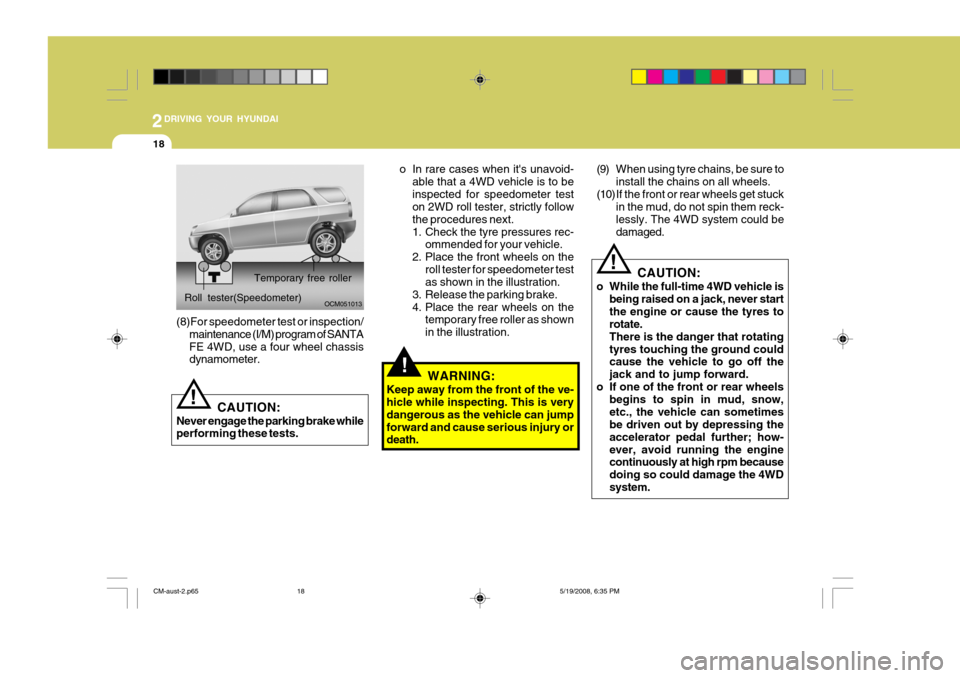
2DRIVING YOUR HYUNDAI
18
!
(9) When using tyre chains, be sure to
install the chains on all wheels.
(10) If the front or rear wheels get stuck
in the mud, do not spin them reck- lessly. The 4WD system could bedamaged.
CAUTION:
o While the full-time 4WD vehicle is being raised on a jack, never startthe engine or cause the tyres torotate.There is the danger that rotatingtyres touching the ground could cause the vehicle to go off the jack and to jump forward.
o If one of the front or rear wheels begins to spin in mud, snow,etc., the vehicle can sometimes be driven out by depressing the accelerator pedal further; how-ever, avoid running the engine continuously at high rpm because doing so could damage the 4WDsystem.
!
WARNING:
Keep away from the front of the ve- hicle while inspecting. This is very dangerous as the vehicle can jumpforward and cause serious injury or death. o In rare cases when it's unavoid-
able that a 4WD vehicle is to be inspected for speedometer test on 2WD roll tester, strictly follow the procedures next.
1. Check the tyre pressures rec-ommended for your vehicle.
2. Place the front wheels on the
roll tester for speedometer test as shown in the illustration.
3. Release the parking brake.
4. Place the rear wheels on the temporary free roller as shownin the illustration.
Roll tester(Speedometer)
(8)For speedometer test or inspection/ maintenance (I/M) program of SANTA FE 4WD, use a four wheel chassis dynamometer.
CAUTION:
Never engage the parking brake whileperforming these tests.
! OCM051013
Temporary free roller
CM-aust-2.p65
5/19/2008, 6:35 PM
18
Page 165 of 269
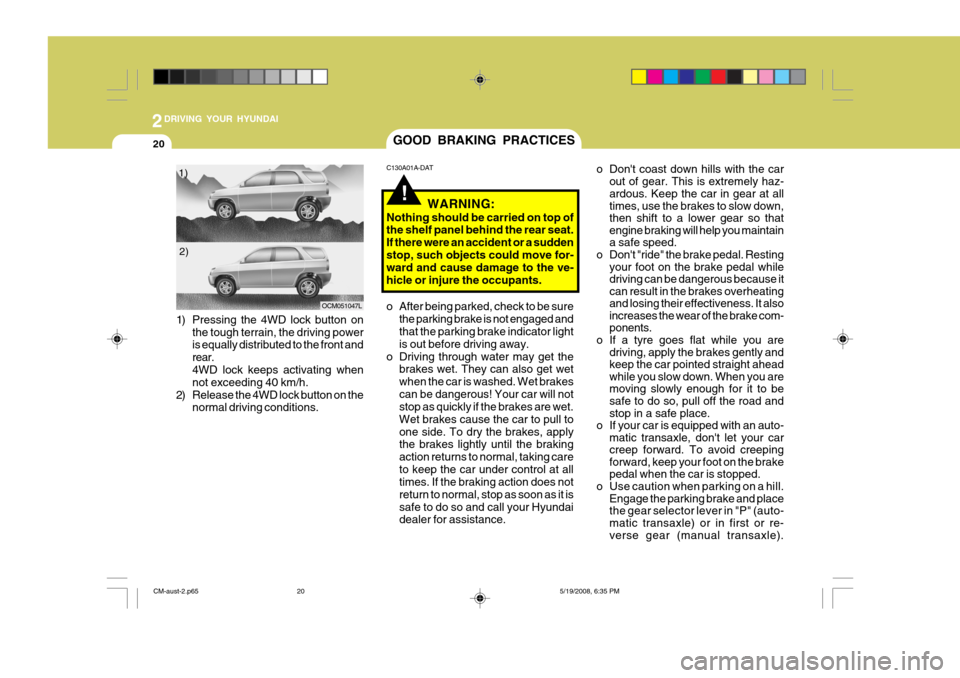
2DRIVING YOUR HYUNDAI
20
!
GOOD BRAKING PRACTICES
C130A01A-DAT o Don't coast down hills with the car
out of gear. This is extremely haz- ardous. Keep the car in gear at all times, use the brakes to slow down,then shift to a lower gear so thatengine braking will help you maintaina safe speed.
o Don't "ride" the brake pedal. Resting
your foot on the brake pedal whiledriving can be dangerous because itcan result in the brakes overheatingand losing their effectiveness. It alsoincreases the wear of the brake com-ponents.
o If a tyre goes flat while you are driving, apply the brakes gently andkeep the car pointed straight aheadwhile you slow down. When you aremoving slowly enough for it to besafe to do so, pull off the road and stop in a safe place.
o If your car is equipped with an auto-
matic transaxle, don't let your car creep forward. To avoid creepingforward, keep your foot on the brakepedal when the car is stopped.
o Use caution when parking on a hill. Engage the parking brake and placethe gear selector lever in "P" (auto-matic transaxle) or in first or re-
verse gear (manual transaxle).
WARNING:
Nothing should be carried on top ofthe shelf panel behind the rear seat. If there were an accident or a suddenstop, such objects could move for- ward and cause damage to the ve- hicle or injure the occupants.
o After being parked, check to be sure the parking brake is not engaged and that the parking brake indicator light is out before driving away.
o Driving through water may get the brakes wet. They can also get wet when the car is washed. Wet brakescan be dangerous! Your car will not stop as quickly if the brakes are wet. Wet brakes cause the car to pull toone side. To dry the brakes, apply the brakes lightly until the braking action returns to normal, taking careto keep the car under control at all times. If the braking action does not return to normal, stop as soon as it issafe to do so and call your Hyundai dealer for assistance.
1) Pressing the 4WD lock button on
the tough terrain, the driving power is equally distributed to the front and rear. 4WD lock keeps activating when not exceeding 40 km/h.
2) Release the 4WD lock button on the normal driving conditions.
1)
2)
OCM051047L
CM-aust-2.p65 5/19/2008, 6:35 PM
20
Page 167 of 269

2DRIVING YOUR HYUNDAI
22SMOOTH CORNERING
C150A01A-DAT Avoid braking or gear changing in cor- ners, especially when roads are wet. Ideally, corners should always be taken under gentle acceleration. If you followthese suggestions, tyre wear will be held to a minimum.
o Don't "labour" or "over-rev" the en-
gine. Labouring is driving too slowly in too high a gear resulting in the engine bucking. If this happens to you, shift to a lower gear. Over-revving is racing the engine beyond its safe limit. This can be avoided by shifting at the recommended speeds.
o Use your air conditioning sparingly. The air conditioning system is oper-ated by engine power so your fueleconomy is reduced when you use it.
o Keep your car clean all over. For
maximum service, your Hyundaishould be kept clean and free of corrosive materials. It is especially important that mud, dirt, ice, etc. notbe allowed to accumulate on the underside of the car. This extra weight can result in increased fuel con-sumption and also contribute to cor- rosion.
o Travel lightly. Don't carry unneces- sary weight in your car. Weight is anenemy of good fuel economy.
o Don't let the engine idle longer than
necessary. If you are waiting (andnot in traffic), turn off your engine and restart only when you're ready togo.
o Remember, your Hyundai does not
require extended warm-up. As soonas the engine is running smoothly, you can drive away. In very cold weather, however, give your enginea slightly longer warm-up period.
CM-aust-2.p65 5/19/2008, 6:35 PM
22